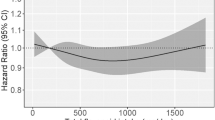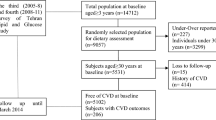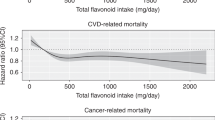Abstract
Objective: Dietary intake of flavonoids has been reported to protect against coronary heart disease (CHD) risk, but associations of specific classes of flavonoids with CHD have not been adequately studied.
Design: Hospital-based case–control study relying on interviewer administered questionnaires.
Setting: Cardiology Department of the University of Athens Medical School in the Hippokrateion General Hospital (1990–1991).
Subjects: Cases were 329 patients with electrocardiographically confirmed first coronary infarct or a first positive coronary arteriogram, or both (participation fraction 93%). Controls were 570 patients admitted to the same hospital for minor conditions unrelated to nutrition (participation fraction 95%). All cases and controls were interviewed in the hospital wards by experienced interviewers, and a 110-item food frequency questionnaire was administered.
Results: There was statistically significant evidence (P∼0.03) for an inverse association between intake of flavan-3-ols and CHD risk, an increase of about 21 mg per day corresponding to a 24% decrease in CHD risk. The inverse association between flavan-3-ols and CHD risk was largely accounted for by the intake of wine and to a lesser extent tea. For none of the other flavonoid classes was there statistically significant evidence of an association.
Conclusion: Flavan-3-ols, which are largely found in wine and tea, are inversely associated with, and may be protective against, coronary heart disease.
This is a preview of subscription content, access via your institution
Access options
Subscribe to this journal
Receive 12 print issues and online access
$259.00 per year
only $21.58 per issue
Buy this article
- Purchase on Springer Link
- Instant access to full article PDF
Prices may be subject to local taxes which are calculated during checkout
Similar content being viewed by others
References
Arts IC, Jacobs DR, Harnack LJ, Gross M & Folsom AR (2001): Dietary catechins in relation to coronary heart disease death among postmenopausal women. Epidemiology 12, 668–675.
Breslow NE & Day NE (1980): Statistical methods in cancer research. Volume I—The analysis of case–control studies. IARC Sci. Publ. 32, 5–338.
Demrow HS, Slane PR & Folts JD (1995): Administration of wine and grape juice inhibits in vivo platelet activity and thrombosis in stenosed canine coronary arteries. Circulation 91, 1182–1188.
Gnardellis C, Trichopoulou A, Katsouyanni K, Polychronopoulos E, Rimm EB & Trichopoulos D (1995): Reproducibility and validity of an extensive semi-quantitative food frequency questionnaire among Greek school teachers. Epidemiology 6, 74–77.
Giugliano D (2000): Dietary antioxidants for cardiovascular prevention. Nutr. Metab. Cardiovasc. Dis. 10, 38–44.
Gryglewski RJ, Korbut R, Robak J & Swies J (1987): On the mechanism of antithrombotic action of flavonoids. Biochem. Pharmacol. 36, 317–322.
Huxley RR & Neil HA (2003): The relation between dietary flavonol intake and coronary heart disease mortality: a meta-analysis of prospective cohort studies. Eur. J. Clin. Nutr. 57, 904–908.
Hertog MG, Kromhout D, Aravanis C, Blackburn H, Buzina R, Fidanza F, Giampaoli S, Jansen A, Menotti A, Nedeljkovic S, Pekkarinen M, Simic BS, Toshima H, Feskens EJM, Hollman PCH & Katan MB (1995): Flavonoid intake and long-term risk of coronary heart disease and cancer in the seven countries study. Arch. Intern. Med. 155 (4), 381–386.
Hertog MG, Feskens EJ, Hollman PC, Katan MB & Kromhout D (1993): Dietary antioxidant flavonoids and risk of coronary heart disease: The Zutphen Elderly Study. Lancet 342 (8878), 1007–1011.
Kalandidi A, Tzonou A, Toupadaki N, Lan S-J, Koutis C, Drogari P, Notara V, Hsieh C-C, Toutouzas P & Trichopoulos D (1992): A case–control study of coronary heart disease in Athens, Greece. Int. J. Epidemiol. 21, 1074–1080.
Katsouyanni K, Skalkidis Y, Petridou E, Polychronopoulou-Trichopoulou A, Willett W & Trichopoulos D (1991): Diet and peripheral arterial occlusive disease: the role of poly-, mono-, and saturated fatty acids. Am. J. Epidemiol. 133, 24–31.
Knekt P, Jarvinen R, Reunanen A & Maatela J (1996): Flavonoid intake and coronary mortality in Finland: a cohort study. BMJ 312, 478–481.
Kromhout D, Bloemberg BP, Feskens EJ, Hertog MG, Menotti A & Blackburn H (1996): Alcohol, fish, fibre and antioxidant vitamins intake do not explain population differences in coronary heart disease mortality. Int. J. Epidemiol. 25, 753–759.
MacMahon B & Trichopoulos D (1996): Epidemiology: Principles and Methods 2nd Ed, pp 229–299. Boston: Little Brown.
Middleton Jr E, Kandaswami C & Theoharides TC (2000): The effects of plant flavonoids on mammalian cells: implications for inflammation, heart disease and cancer. Pharmacol. Rev. 52, 673–751.
Peterson J & Dwyer J (1998): Flavonoids: Dietary occurrence and biochemical activity. Nutr. Res. 18, 1995–2018.
Polychronopoulou-Trichopoulou A (1989): Composition of Greek Foods and Recipes. Athens: Parisianos.
Puddey IB & Croft KD (1999): Alcohol, stroke and coronary heart disease. Are there antioxidants and pro-oxidants in alcoholic beverages that might influence the development of atherosclerotic cardiovascular disease? Neuroepidemiology 18, 292–302.
Rimm EB, Katan MB, Ascherio A, Stampher MJ & Willett WC (1996): Relation between intake of flavonoids and risk for coronary heart disease in male health professionals. Ann. Intern. Med. 125, 384–389.
Rosenkraunz S, Knirel D, Dietrich H, Flesch M, Erdmann E & Bohm M (2002): Inhibition of the PDGF receptor by red wine flavonoids provides a molecular explanation for the ‘French paradox’. FASEB J. 16, 1958–1960.
Soleas GJ, Diamantides EP & Goldberg DM (1997): Wine as a biological fluid: history, production, and role in the disease prevention. J. Clin. Lab. Anal. 11, 287–313.
Trichopoulou A (1992): Composition of Greek Foods and Dishes. Athens, Greece: Athens School of Public Health.
Tzonou A, Kalandidi A, Trichopoulou A, Hsieh C-C, Toupadaki N, Willett W & Trichopoulos D (1993): Diet and coronary heart diseases: a case–control study in Athens, Greece. Epidemiology 4, 511–516.
US Department of Agriculture (2003): USDA Database for the Flavonoid Content of Selected Foods. Beltsville, MD: USDA.
US Department of Agriculture (2002): Iowa State University Database on the Isoflavone Content of Foods, Release 1.3—2002. Beltsville, MD: USDA.
Van Jaarsvelt H, Kuyl JM, Schulenburg DH & Wiid NM (1996): Effect of flavonoids on the outcome of myocardial mitochondrial ischemia/reperfusion injury. Res. Commun. Mol. Pathol. Pharmacol. 91, 65–75.
Yochum L, Kushi LH, Myer K & Folsom AR (1999): Dietary flavonoid intake and risk of cardiovascular disease in postmenopausal women. Am. J. Epidemiol. 149, 943–949.
Acknowledgements
This study was partially supported by the University of Athens and a grant to Harvard University by the Samourkas Foundation. The project was also funded in part with Federal funds from the US Department of Agriculture Research Service under contract number 58-1950-9-001. The contents of this publication do not necessarily reflect the views or policies of the US Department of Agriculture, nor does mention of trade names, commercial products, or organizations imply endorsement by the US government. Partial support was also provided by the State of Florida, Department of Citrus.
Author information
Authors and Affiliations
Contributions
Guarantor: D Trichopoulos.
Contributors: PL: lead investigator, supervisor of all activities and manuscript developer. ES: Statistical analysis. AL: Epidemiologist and contributor in manuscript drafting. AT: Statistical analysis. AK: Design of the original study and supervision of data collection. JP: Contribution in development and application of flavonoid content data. JD: Contribution in development and application of flavonoid content data. DT: Design of the original study; senior epidemiologist.
Corresponding author
Rights and permissions
About this article
Cite this article
Lagiou, P., Samoli, E., Lagiou, A. et al. Intake of specific flavonoid classes and coronary heart disease—a case–control study in Greece. Eur J Clin Nutr 58, 1643–1648 (2004). https://doi.org/10.1038/sj.ejcn.1602022
Received:
Revised:
Accepted:
Published:
Issue Date:
DOI: https://doi.org/10.1038/sj.ejcn.1602022
Keywords
This article is cited by
-
Bioactive compounds and antioxidant activity in scalded Jalapeño pepper industrial byproduct (Capsicum annuum)
Journal of Food Science and Technology (2017)
-
Flavonoid classes and risk of peripheral arterial occlusive disease: a case–control study in Greece
European Journal of Clinical Nutrition (2006)
-
Controllable Regioselective Acylation of Rutin Catalyzed by Enzymes in Non-aqueous Solvents
Biotechnology Letters (2005)



